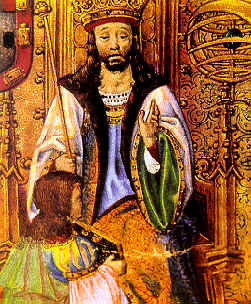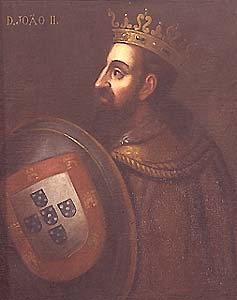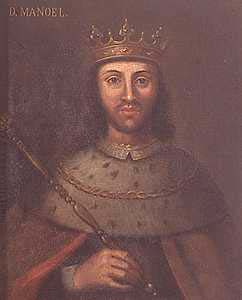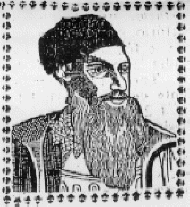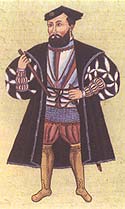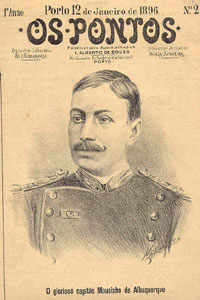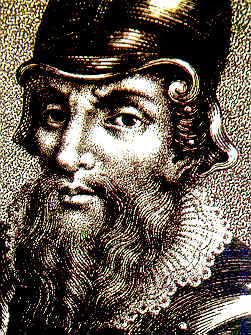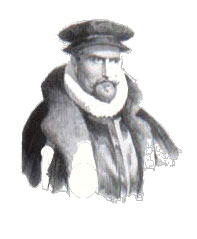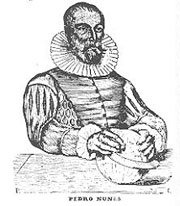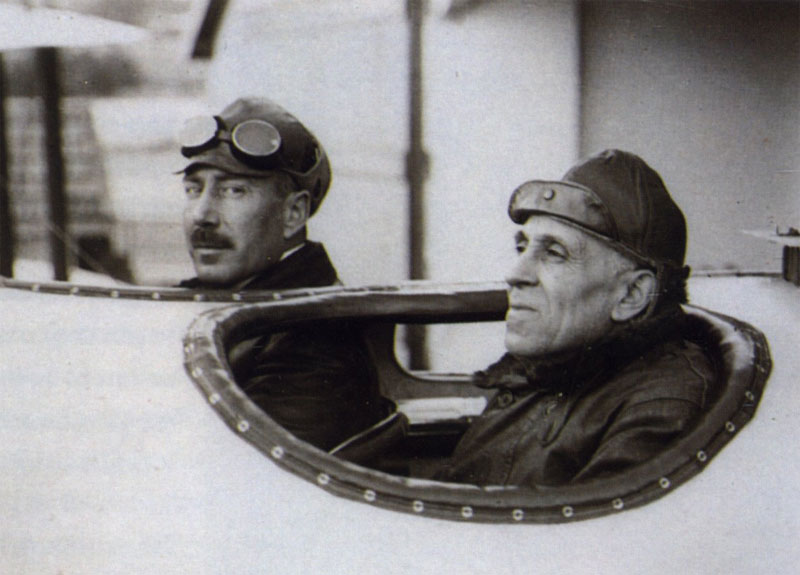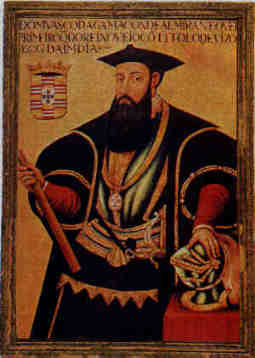Thirteenth king of Portugal (third of the second dinasty). His father Dom Duarte died when Afonso was still a child (the first regent was Afonso's mother, and the second was Dom Pedro, his uncle and brother of the late king). During the Regency of Dom Pedro, the country prospered and it was during this period that Henry's captains explored much of the Atlantic. The duke of Bragan�a - enemy of Dom Pedro who had tried to tame the nobility - persuaded the young king to fight the prince-regent at the battle of Alfarrobeira (1449) where the latter was killed. Thus died the best son of king John the great.
Having secured political stability, the king engaged a policy of conquest in Northj Africa, conquering Alc�cer-Cegu�r (1458), Anaf� (1464), Arzila, Tangiers and Larache (1471). After his conquest that earned him the name "The African", king Dom Afonso V turned his atentions to the Iberian Peninsula invading Castille to help the cause of princess Juana, that was fighting the claim of the Catholic Kings (Ferdinand of Aragon and Isabella of Castille). After the battle of Toro, the Portuguese pretensions to an Iberian union based in Lisbon were lost. Disappointed, Dom Afonso abdicates (1477) in favour of his son Dom Jo�o II, eventually dying in 1481.
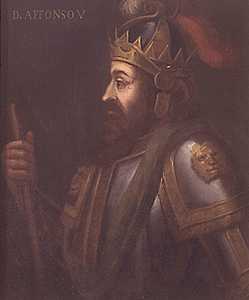
Portuguese aristocrat born in Alhandra, southern Portugal, who was related to the Portuguese royal family. Raised in the court of the king Dom Afonso V, he served in several of the Portuguese fortresses in Morocco and eventually joins the personal guard of the king Dom Jo�o II. In 1503, the king Dom Manuel I appoints him to his first assignment in India. He builds the fortress in Cochim, and although always severely outnumbered he fights the Turk and the Muslim mercenaries of the Calicut kingdom. In 1506, he returns to India with a secret letter of the king which named him the new governor (thus displacing Dom Francisco de Almeida). After the arrival of a Portuguese fleet, he puts his plan in motion: he storms the ports of Oman (Arabia) and of Hormuz (Persia), being repelled from the later.
His plan was ambitious: to take a number of strategic fortresses in the Persian Gulf, in the Red Sea and in the Straight of Mallacca, from which the Portuguese fleets could sink all foreign vessels sailing through the Indian Ocean. Thus, he conquers Goa (India) in 1510, Mallacca in 1511, and Hormuz in 1515. The conquest of Aden (Red Sea) fails, but his previous conquests made the Portuguese the undisputed rulers of the Indian ocean for the rest of the XV century. His success got him many enemies, and he was recalled to Goa to be replaced. He died at sea, in sight of the city. Albuquerque is most likely the greatest man in Portuguese history.
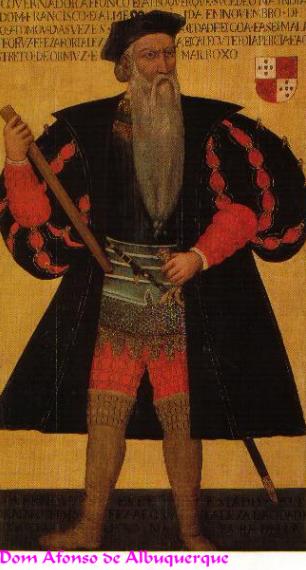
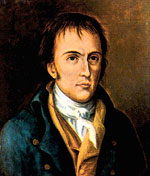
Portuguese poet, and undoubtedly the best representative of the Lusitanian Arcadianism. Despite having been an icone of this literary movement, his writings are a transition between the neo-classic and the romantic.
The poet described hilmself as "thin, blue-eyed, and with a dark skin".
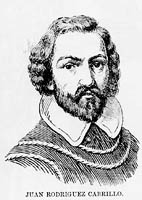
Portuguese XVI century explorer. He won his place in history for being one of the first Europeans to explore the western coast of the North American continent, at the service of the Crown of Spain. He died on the 3rd of January of 1543 in California.
Portuguese Humanist born in 1502 in the city of Alenquer. In 1523 he is sent to the Flanders, where he meets Erasmus. In 1531 he is sent in another royal assignment, and he meets Martin Luther and Melanchton. He settles in Lovaine, where he marries Joan Van Hargen.From 1538 to 1567, he writes several books with themes as vaired as the Roman writer Cicero, the management of Portuguese affairs in India, religion, the city of Lovaine and Lisbon, and the biographies of king Dom Manuel and of prince Dom Jo�o.In 1542 Lovaine is stormed by the French, and Dami�o de G�is is reputed to have been one of the most corageous defenders.
His writings about religion got him into trouble with the Inquisition, and he was sentenced in 1572 to life imprisonment. He died in his house two years later, possibly murdered.
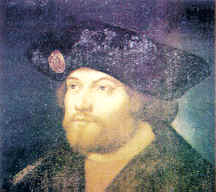
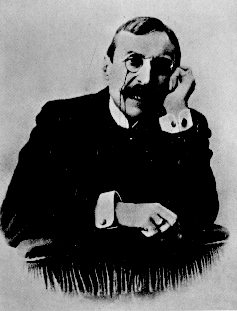
Considered by many the best realist writer of Portuguese literature, he was also the Portuguese consul in Havana, Bristol and in Newcastle. His most famous book is "Os Maias" which was translated to up to twenty diferent languages.
Portuguese neurosurgeon and recipient of the Medicine Nobel Prize (1949) for inventing the - now outdated - surgical procedure known as lobotomy.
In 1911 he became the main professor of Neurology in the University of Lisbon. Later he created a school for neurology and neurosurgery. He left over three hundred writings concerning medicine, history, literature, art and politics.
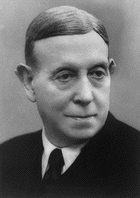
Nineth king of Portugal, and the last king of the first dinasty. With the exception of a law that increased the agricultural produce of the country, his rule was a complete disaster that included several lost wars with Castille, and his death ended up seriously compromising the Portuguese independence.
He was known as "The fair" for his good looks. He found his place in this gallery mainly to show that the Portuguese - both the competent and the incompetent - always looked like Portuguese.
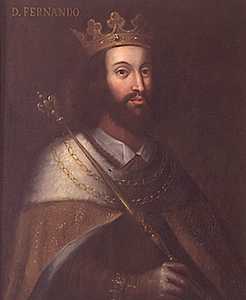
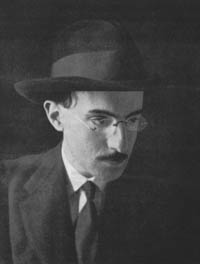
Considered by many the best Portuguese poet after Cam�es. The literary critic Harold Bloom considered him to be one of the two most representative poets of the XX century (the other being Pablo Neruda).
Ferdinand Magellan was a Portuguese warrior and explorer credited for leading the expedition that finally circumnavegated the globe, thus proving that the Earth was round. He died fighting in the Phillipinnes. Out of the 250 original crewmen, only 18 returned to Spain alive.
Prior to his most celebrated expedition, Magellan had been part of the first fleet led by Dom Francisco de Almeida (1505), in the conquest of Mallaca (1511) under Dom Afonso Albuquerque, and he also saw combat in Azamor (Morocco) where he was wounded. Magellan Straight is named after him.
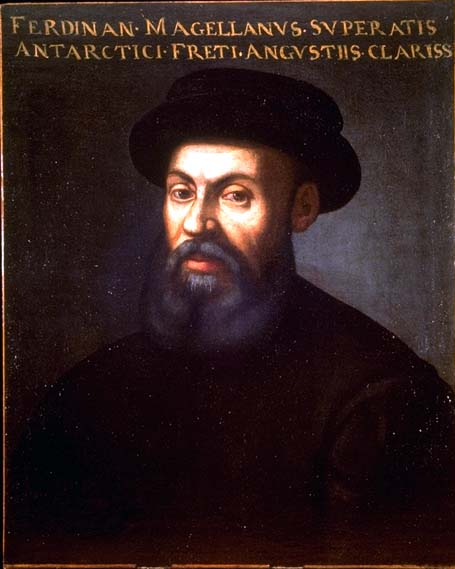
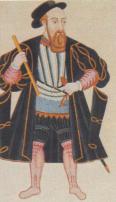
Francisco de Almeida first distinguished himself at the battle of Toro (1476), and a few years later at the conquest of the kingdom of Granada (1492). In 1505, king Dom Manuel I of Portugal sends a powerful fleet under his command to India to defeat the Turkish navy. He achieves total success by 1509, forcing the Turks to leave the Indian ocean for the next twenty nine years. Nominated vice-roy, he was replaced by Afonso de Albuquerque in 1509.
Dom Francisco de Almeida was crucial in the establishment of Portuguese hegemony in the Indian ocean.
He was the most important personality of the Age of Explorations. In 1414, he persuaded his father to conquer Ceuta (conquered in 1415). In 1416, he started building his naval school in Sagres, which became a state-of-the-art science centre for astronomers, geographers, naval builders, and explorers. The discovery of the island of Madeira was the first fruit of these enterprise. In 1427, the first islands of the Azores archipelago are found. In 1434, the Cape Bojador (until then considered the end of the world) is crossed by Gil Eanes. In 1441, Cap Blanc. In 1443, Arguin Bay. In 1444, Cape Verde and the river Senegal. In the 1450s, the Cape Verde archipelago is found.
Despite his responsibilities in the military failure of Tangiers (1437), prince Henry's actions gave Portugal a valuable head-start concerning the explorations and the colonization of the New World.
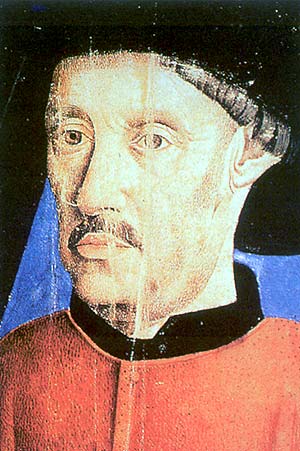
Born in Lisbon, he would die in Goa having been a governor, a captain-general, the 14th governor and the 4th vice-roy of the Portuguese-Indian Empire.
He was educated by the great Portuguese mathematician Pedro Nunes together with Dom Luis, son of the king Dom Manuel. When he was 18, he embarked to Tanger where he served for nine years under Dom Duarte de Menezes who knighted him for his bravery. In 1535, he served under the emperor Charles V in his expedition to Tunis, where once again he distinguished himself.
In 1538 he leaves to India. In 1540, he is the captain of a galleon that is sent by the Portuguese - together with another 11 galleons and 60 oar-powered ships - to fight the Turks in the Red Sea.
He returns to Portugal, and by 1543 he is appointed as the general of the coastal armada, which had the duty of protecting the Portuguese coast and the Portuguese convoys from the Indies against pirates. In this role, he defeated seven pirate ships. Because of this great victory, he succeeds the great Martim Afonso de Sousa (13th governor of the Indies) after being appointed by the king for the role of governor. He leaves for India in March of 1545 commanding a fleet with 6 galleons and over 2000 men that arrived in September of the next year. Upon his arrival, he defeats Hidal Khan near Goa, and Coge Sofar near Diu. To rebuild the fortress of Diu, he asks the Goa city-council for a loan (presenting the council with his own beard as a garantee, as he had no fortune of his own). Impressed by his sense of honour and devotion to the royal cause, Goa responded with a quantity that exceeded Castro's expectations and returned him his own beard. The letter that accounts for this incident is dated 27 December of 1547.
After Diu, he defeats once again Hidal Khan near Goa, this time destroying the Mughal ruler's ports. In Lisbon, the king rewarded him by naming him vice-roy of the Indies. Dom Jo�o didn't enjoy this reward, as he died in the arms of the apostle of the Indies, St Francis Xavier. His remains - as is his beard - were transported to Portugal where they remain.
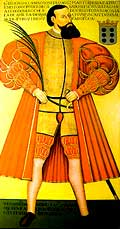
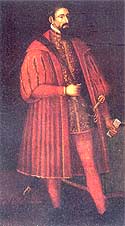
Tenth king of Portugal, founded the second dinasty in 1385 after overwhelmingly defeating the Castillian king Don Juan in the battle of Aljubarrota. When king Dom Fernando died, his only dauther Beatriz was already married to the king of Castille (thus endangering Portuguese independence). The popular Dom Jo�o, being an illegitimate son of the late king Dom Pedro, claimed the throne for himself. In 1387, Dom Jo�o marries Filipa de Lencastre (Phillippa of Lancaster), daughter of John de Gaunt, duke of Lancaster, thus strengthening the ties between Portugal and England. King Dom Jo�o then promoted the economic and social development of his country, he fortified its borders, and in 1415 he invaded Morroco (conquering Ceuta) giving birth to the Portuguese Empire. During his rule, the Portuguese started exploring the Atlantic.
He fathered king Dom Duarte, the duke of Coimbra Dom Pedro (one of the most educated princes of the century), the duke of Viseu Dom Henrique (prince Henry the navigator, who started the Age of Explorations) and Dona Isabel (who married the powerful duke Phillip III of Burgundy).
Dom Jo�o I is known as "The Great", "The Good" or the "The well remembered".
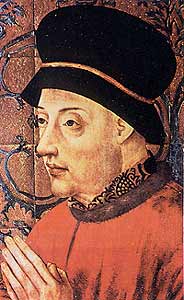
Son of the king Dom Afonso V, Dom Jo�o II would be the kind of ruler that Machiavelli used as a model for his book "The Prince".
In 1453, the Turks capture Constantinople. In 1456, they threaten Belgrade. Pope Calistus III declares a Holy Crusade, but the only ruler in Europe to listen to him is king Dom Afonso V (Dom Jo�o's father). Thus, he prepares an army of 12,000 men to be sent against the Turks. In 1458, the pope dies - together with his crusade - and the king decides to send this new army against the Moors of Morroco. Alcacer-Ceguer is captured in 1458, and in 1471 Arzila is conquered and Tangiers is occupied. Prince Dom Jo�o participates in this last campaign, where he was knighted. In 1475, king Dom Afonso V invades Castille to defend the pretensions of Joana, daughter of the late weak king Enrique IV, leaving his son prince Dom Jo�o ruling Portugal. In 1475, Dom Jo�o himself invades Castille and defeats Ferdinand the Catholic at the battle of Toro. In 1481, king Dom Afonso dies and prince Dom Jo�o becomes king Dom Jo�o II.
Dom Jo�o started his rule by taming the nobility and restricting her liberties (extended during the rule of his father). He would be content with nothing less than absolute power. He started by listening to the complaints made by the populace regarding the abuses of the aristocracy. He would use these complaints as a pretext to eliminate some of the most powerful nobles that could threaten his own power: the duke of Bragan�a (whose house had been involved in the fall of the prince-regent Dom Pedro) is decapitated; the duke of Viseu - brother of the queen - is stabbed to death by the king himself; the bishop of �vora is poisoned while in prison. Now, the perfect prince can rule. He will strengthen diplomatic ties with other European countries, reorganize the State, and support the naval explorations started by his great-uncle Prince Henry.
During his rule, the Portuguese will reach the shores of Angola, and in 1488 the Indian ocean itself: India is ever closer. In 1492, Christopher Columbus - whose expeditions Dom Jo�o rejected - finds the Antilles. In 1494, the world is divided between Spain and Portugal.
In 1495 dies Dom Jo�o II, the Perfect Prince as Portuguese History remembers him or the Tirant according to the aristocracy of his days. Queen Isabella the Catholic simply called him el hombre - the man. Upon hearing of his death, she sighed with a mix of admiration, relief and sadness: "The man is dead".
Rui de Pina, the XV century biographer of the king gives us a very good physical description of Dom Jo�o II: "His face was longer than it was round (...), his hair was brown and long (...), his nose was long and pointed slightly downwards. Of pale complexion everywhere but his face, which had colour (...).
